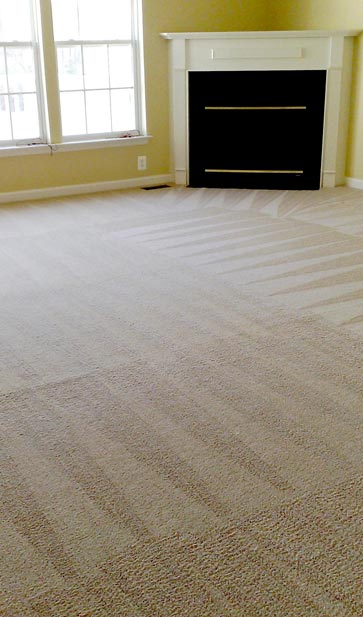 |
Our Unique 7 step carpet Cleaning Process1. Pre spotting during carpet cleaning All spots and stains will have been tested to determine the original cause of the mark .This can be done using a number of techniques if the owner is unable to inform us. Like using 3 of the sensory perceptions; look, touch and smell. Once that has been done each mark must be spotted with the chemicals required to help remove them. This is done prior to cleaning as very often the mark will disappear after cleaning and reappear some days later if it is not correctly treated. The reason for this is that the substances present causing the mark has not been rinsed out and so dirt sticks to it and then the mark will gradually reappear. This is very common with marks caused from detergent, sugar or oil. Our cleaning teams are trained to pre test black marks to determine if their origin was detergent, sugar or oil/grease. This is done with a small amount of warm water applied to the area and rubbed with the thumb nail. 2. Edges in our carpet cleaning process All edges are hand pre scrubbed with a hand brush to ensure all edges and corners are cleaned, as the rotary scrubber will not be able to reach them. It also serves to prevent skirtings from getting bumped and scratched. Hand scrubbing helps to access the nooks and crannies were little creepy crawlies get stuck and dust that has not been removed from regular house hold vacuuming has been missed. 3. Scrubbing or agitation in our carpet cleaning This is an essential action in the cleaning of your carpet. The dirt needs to be adjitated to loosen it and to get it up from the bottom of the carpet. Many cleaners do not make use of this step and as a result leave impacted dirt in your carpet, only cleaning the surface dirt off. This is a systematic motion of moving from left to right and back again , ensuring that every area gets at least a double turn of scrubbing if not more . Imagine if you only poured shampoo on your hair and then just rinsed it off without massaging it into your scalp, this at best would only clean the top layer of dirt stuck to the surface of your hair , not a very satisfactory cleaning result. 4. Vacuum ,Extraction This is the suction, vacuum motion of extracting the shampoo and dirt from the carpet. It is done by a machine that has 2 tanks. 1 empty one and one filled with clean water and a PH corrective. Attached to this machine is a concertina hose and a thinner high pressure hose. At the end of both of these hoses is attached a stainless steel wand with a flat head at the one end that has 4 tiny jets. The clean water is atomised through these jets onto the carpet and the dirt and shampoo are sucked up by the extraction flat head. The flat head is systematically pushed up and down in rows there by extracting the dirt from the carpet. It is this machine that leaves the v design on the pile if the pile is not set. 5. Pre Spray All fitted carpets are pre-sprayed with the correct detergent for the fibre of the carpet. This is important as different fibres react differently to different chemicals. There is no such thing as a generic carpet shampoo. The soiling on the carpet will also determine if other chemicals should be used on particular areas as well as the amount of detergent that is applied. Yes sometimes your carpet is so full of shampoo from previous cleanings; we do not need to use any of our own. The reason for your carpets being full of shampoo is the people that have previously cleaned them failed to rinse the shampoo out. The reason your carpets looked great after they were cleaned and then got dirty very quickly afterwards. The cause of the rapid soiling is the residual shampoo sitting in your carpet that is sticky and attracts dirt. A carpet can hold up to 4 kg of dirt per square meter before it even looks dirty. In fact, studies have proven that over 75% of the soil found in a carpet will be dry dirt. All this dry soil and grit abrades the carpet down and damages the fibres over time as people walk over it. It is very important to vacuum your carpet daily if it takes a lot of traffic 6. Rinse and Ph corrective. Rinsing is imperative for a lasting clean. After the full wash the carpet will need to be rinsed with fresh water, using our water injection system. Without a thorough rinse process the carpet will retain emulsified soil and shampoo in its fibres. This will leave a sticky residue which will cause rapid re soiling of the carpet once dry. It is also in this stage that a ph corrective could be applied to the carpet in the rinse water. A Ph corrective should be administered especially in the case of a natural fibre carpet, to help reduce the possibility of browning and also it will lift the colours of a brightly coloured carpet .All carpets have a natural Ph that enhances their appearance . 7. Pile setting or grooming after carpet cleaning All carpets should have the pile set standing up. This ensures that there is an easy flow of air through the carpet fibres ensuring a quicker drying time and a revitalised pile which is all lying in the correct direction. It also gets rid of the v pressure marks left behind by the steam machine and possibly the scrubber. All carpets have a pile whether cut or looped.
|

